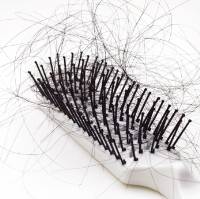Hair loss menopause is a widely experienced side effect of the so-called “change of life.” Hair loss menopause is a complex process that causes significant changes in a woman’s body. During menopause estrogen and progesterone levels fluctuate, causing imbalances. These imbalances can result in a sensitivity to testosterone which in turn can lead to hormone-related female pattern hair loss. Hair begins to recede at the temples and thinning may be seen as a diffused general pattern over the entire scalp. Unbalanced by estrogen, testosterone occurring in the scalp is acted upon by the enzyme 5-alpha reductase and becomes dihydrotestosterone (DHT).
Click Here For Some Helpful Solutions To Hair Loss Menopause!
DHT attacks the hair follicle, causing it to miniaturize and produce thinner and thinner hair. Eventually the hair becomes transparent and falls out. At this point, the follicle ceases to produce any hair at all. Hair loss menopause at mid-life is more likely to be genetically caused than related to diet or lifestyle. Approximately half of all menopausal women will experience some degree of hair loss. Two-thirds of post-menopausal women will have to contend with bald spots or thinning hair.
Hair loss in women was once understood than hair loss in men. But it appears to be a much more complex process. There is evidence that other types of enzymes, in addition to 5-alpha reductase, are involved in hair loss menopause. Hormone receptors and hormone blockers may also play a part. There are significant differences between the pattern on hair loss between men and women. Men lose their hair in specific areas at the temples and crown. Female hair loss encircles the whole top of the head — it’s diffuse. The role of genetics in male balding is well understood — less so in females. In cases where the hair loss is androgenic — caused by male hormones like testosterone — there is treatment available.
One of the most popular treatments is minoxidil, an FDA-approved topical treatment that blocks the action of DHT on the follicles, preserving the hair. Since DHT causes the follicles to miniaturize, another benefit of minoxidil is that it lengthens the follicle and makes it larger. This can extend the growth phase of the follicle. Sold under the brand name Rogaine®, minoxidil comes in two strengths, 2% and 5%. The 2% strength is not effective for female pattern hair loss, but if you use the 5% solution, you may experience some irritation of the scalp, itching or dryness. Many doctors have customized versions of minoxidil available for hair loss menopause that help to minimize discomfort and irritation.
Women may also benefit from the prescription drug finesteride for treatment of hair loss menopause. Sold under the name Propecia®, the drug was originally intended to treat prostate disease in men but was found to have benefits related to male pattern hair loss caused by DHT. Finesteride is an oral medication that works by inhibiting the action of the 5-alpha reductase enzyme, thus blocking the production of DHT. If used long enough and in high enough doses, both minoxidil and finesteride can help regrow hair.
Women should also be aware that doctors who treat hair loss have special formulations and preparations that can reduce side effects. These formulations may also contain vitamins and minerals known to be beneficial to the hair, like the B-complex, zinc and biotin. Now that the causes of hair loss menopause are better understood, effective treatments are widely available.
Click Here For Some Helpful Solutions To Hair Loss Menopause!

